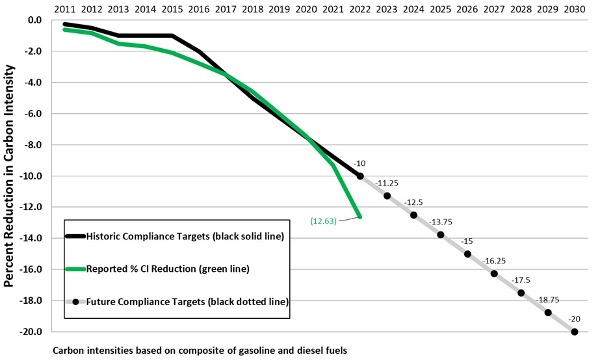California Low Carbon Fuel Standard (LCFS)
Life Cycle Associates helps companies get certified and comply with California’s Low Carbon Fuel Standard (LCFS), including certification for both Tier 1 and Tier 2 fuel pathways. Implemented by the California Air Resources Board (CARB), the LCFS sets increasingly stringent carbon intensity (CI) reduction requirements for various renewable fuels.
Our work with LCFS certified fuel pathways includes:
- Lookup Table, Tier 1, and Tier 2 fuel pathways using the CA-GREET3.0 model
- Applications certified using the older generation CA-GREET2.0 model
- Pathways certified under initial validation and subsequent annual verification
LCFS Fuel Pathway CI Reduction Requirements

Our CA-GREET experience
Our extensive experience with the California Low Carbon Fuel Standard (LCFS) includes developing the original model for CA-GREET. CA-GREET is the California-specific version of Argonne National Laboratory’s GREET life cycle model which is used to calculate GHG emissions for the LCFS. We work with clients using the CA-GREET 3.0 model and Tier 1 Simplified CI Calculators. The latest CA-GREET version has both Tier 1 and Tier 2 fuel pathways in the same file and additionally has Tier 1 simplified CI calculators for some specific pathways.
Low Carbon Fuel Standard (LCFS) Tier 1 pathways
|
Fuel Type |
Feedstock Examples |
|
Ethanol |
Corn, Corn Fiber, Sorghum, Sugarcane |
|
Biodiesel |
UCO, Tallow, Soybean, Distiller’s Corn Oil, Canola |
|
Renewable Diesel |
Tallow, Distiller’s Corn Oil, Fish Oil |
|
Biomethane (CNG, LNG) |
Dairy Manure, Landfill Gas, Waste Streams |
|
Electricity |
Various |
Indirect Land Use Change (iLUC) analysis
Certified renewable fuels for the California Low Carbon Fuel Standard are calculated on a full life cycle basis, which includes indirect land use change (iLUC). These are set as default values for different feedstocks and fuels based on geography. Through a petition process, fuel producers can submit pathway applications seeking less punitive iLUC scores based on their unique production processes.
We have long standing experience working with pathway petitioners and CARB staff through the LCFS land use change assessment process. Our familiarity with the Global Trade Analysis Project (GTAP) model and AEZ-EF model as supporting documentation supports updated iLUC values.
Hydrogen Refueling Infrastructure (HRI) application support
A 2018 ammendment to the Low Carbon Fuel Standard added a crediting provision for zero emission vehicle (ZEV) infrastructure, designed to support the deployment of ZEV’s across the state. The ZEV infrastructure provision covers Hydrogen Refueling Infrastructure (HRI) and there are more than 70 hydrogen refueling stations in California. We work with operators through the HRI Application process to ensure their technology qualifies for both LCFS credits and infrastructure credits.
High Speed Rail (HSR) Energy Efficiency Ratio (EER) analysis
Our additional LCFS experience includes energy efficiency ratio (EER) analysis for high speed rail (HSR). HSR falls under the category of Other Electric Transportation Applications that may qualify for LCFS credits. High Speed Rail is currently not a certified fuel pathway in the California Low Carbon Fuel Standard Regulation. LCFS credits and deficits are determined for a fuel based on the amount sold, its CI, and the efficiency by which a powertrain converts the fuel into useable energy.
Questions
Do you have questions about the California Low Carbon Fuel Standard as it applies to your specific business case?
